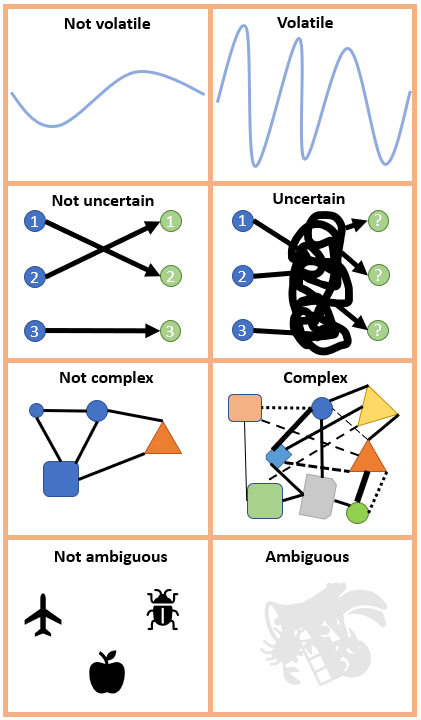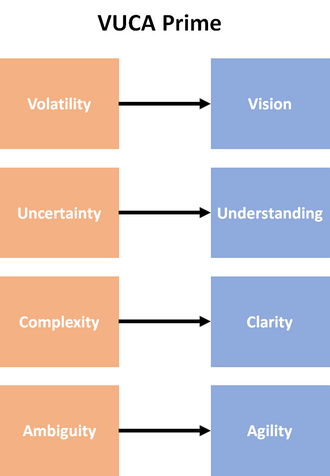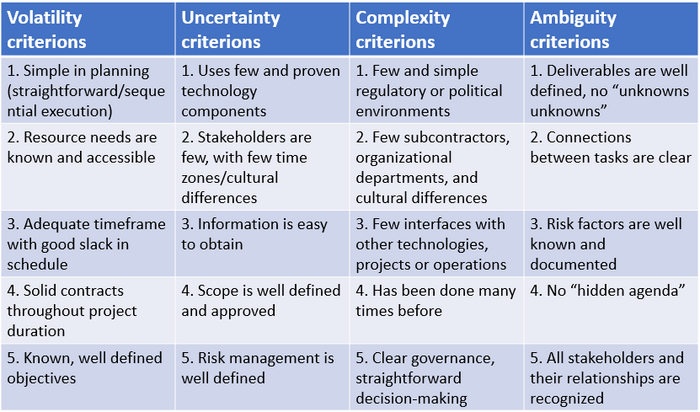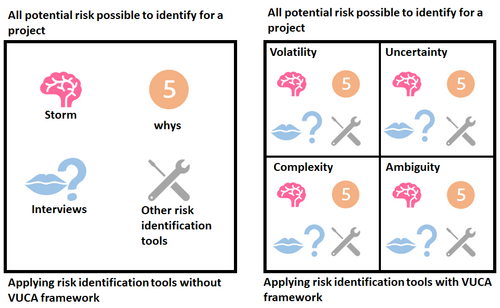VUCA
Contents |
Abstract
Developed by Magnus Leick
VUCA is an acronym for volatility, uncertainty, complexity and ambiguity, which are characteristics that can be used to describe projects environments. It is useful for project managers to know what characterizes the environment in which a project take place, as it will help choosing the correct strategy and leadership approach appropriate for the given environment. Volatile conditions should be dealt with by agility by being able to operate despite changing circumstances, while it is important that the project leader maintains vision for the long-term goal. Uncertain conditions are counteracted by obtaining new information and challenging current perceptions and a project leader should focus on understanding internal and external stakeholders and their beliefs about the situation. Complexity can be dealt with by restructuring the internal structures of a project to fit the environment, rather than the other way around, while a project leader needs to obtain clarity throughout the whole operation, to ensure transparency and not let the complexity ruin the overview. Ambiguity is best dealt with through experimentation and constant incremental learning of the conditions of the environment, while the project leader must show agility in responding to new information and change strategy accordingly. The risks that are relevant to a given project heavily relies on the VUCA characteristics of the given environment.
The PMBOK guide 6th edition mentions VUCA as a potential framework to assist risk identification tools and techniques, but does not elaborate on the term or provides a specific procedure for doing so. The PMBOK guide 7th edition recognizes volatility, complexity and ambiguity as terms influencing the 'Uncertainty domain' of project management dealing with the environment of projects, where the VUCA term as a whole is not directly used, but the characteristics are individually considered. In this article, VUCA has been explained as a whole, providing an overview of characteristics based on individual literature and articles along with the PMBOK perception of the characteristics. This is then related to the concrete tools 'The VUCAlity of projects' and 'The VUCA meter' providing a concrete framework for risk identification of a project, used as an addition to standard risk identification tools and techniques available in the PMBOK 6th edition.
VUCA
The term VUCA is an acronym for volatility, uncertainty, complexity and ambiguity. Originally the term was coined by Warren Bennis and Burt Nanus in 1985 in their book ‘Leaders: Strategies for Taking Charge’. Here the term was created in order to describe the corporate environment in which leaders had to operate and make decisions in. It was later adopted in the US military vocabulary and military training in order to better describe the conditions and environment of the world following the fall of the USSR. As it was a time posing new changes to the global environment of politics, economics and conflicts. It has later been adopted to help understand other environments as well, such as for the global market and projects. [1]
Each concept in VUCA can be considered a characteristic which can be used to help describe and understand the environment in which projects take place. Understanding the context of project is crucial in an ever-changing world where it is impossible to separate a project from the social environment in which it takes place. The concepts of VUCA can help project managers understand the context of their project and the most appropriate approach to navigate in and manage the project risks.
The 7th edition of the PMBOK guide describes 8 performance domains XXXX One of the domains is 'UNCERTAINTY' - despite not mentioning VUCA directly, it describes complexity, ambiguity and volatility as terms that can define project environments in various ways under the umbrella term 'uncertainty' as an overall performance domain. [2] VUCA will here be defined using Bennett and Lemoine's work, as their description is explicitly on VUCA as a term, but will be supplemented with the PMBOK guide and its perspective on the individual characteristics. [3]
Volatility
An environment that is volatile is one that often experiences rapid change of circumstances, which be both be predictable and unpredictable circumstances. The given environment does not have to be particularity complex or lack critical information for the project, as volatility refers to environments that have clear information available and the context is clear, but the environment changes and the outcome might not always be predictable.
Example in Project Management
Conducting a project dependent on a specific resource with rapid changes in its supply/availability can create a volatile environment for a project dependent on a steady supply of that specific resource. This could be the supply of physical resources, labour, services, etc.
To deal with an environment that is volatile requires to prepare for the potential changes. This can be through hedging the volatile risk to multiple sources or stockpiling on the resources that could have volatile supply or price fluctuations. Ensuring that the project has agility and can continue despite an environment that might or might not suddenly change is key to operating in volatile environments. [4]
Uncertainty
Uncertainty characterizes environments where the cause of an event is understood, but it is unknown when and which implications it will have for the project, if any at all. Therefor it makes it hard if not impossible to make valid plans or choices in response to events, with the current information available.
Example in Project Management
Conducting a project in a foreign country could pose uncertainties unfamiliar to a project manager. This could be related to different natural environment in the country, political unrest or culture differences. The situation here is known, but their implications for a potential project might not be.
Gathering information is the core tasks in dealing with uncertainty. As uncertainty is due to lack of information it is necessary to reach beyond what the project manager and the company already know and expand on current knowledge and beliefs. This could be by seeking out information already existing in the world such as establishing new partners whom might be more experienced in the specific field/environment, or it could be generating new information by conducting research in the field.
Complexity
Complexity characterizes environments where information is well known or obtainable and their associated effect on the project can be determined, but the vast amount of data and information to consider makes the project complex and increases risks associated with not being able process all the information correctly.
Example in Project Management
Conducting a project that spans its influence across several countries and local legislations pose substantial complexity to a project. There might be multiple different sets of regulations, documentations requitements, laws, procedures etc. all applying to the same project. All of them are well know and can easily be looked up, but the vast amount of information, rules, limitations etc. make sit hard to navigate in.
The key to dealing with complex environments is restructuring the organization, project and internal operations to fit the external environment, rather than insisting on keeping the same internal structures and trying to make the complex environment fit the current structure of the project or organization. A project team might have to be restructured or different teams be assigned new and clear areas of responsibility in order to obtain a better suited project for the environment.
Ambiguity
Ambiguity characterizes environments where it is hard to predict the outcome of specific events or changes to the environment. This happens in situations that are unique in their form and/or context. This makes it hard to determine the outcome, since there is no past information to help predict it.
Example in Project Management
Conducting mega projects that are unprecedented in history pose ambiguous environments as well as projects at the border of human knowledge and the future. The international space station is an ambiguous project that has taken incredibly long to develop to its current state exactly because it is in new environments with new technology requiring a lot of experimentation and testing before implementing new developments to the station.
Experimentation is required to combat ambiguity. It should be experimented what cause and effect a given action might have in an ambiguous environment. It might be necessary to experiment in increments and split the project into multiple minor parts in order t find out what works best, before taking huge risks by going all in with a specific solution/decision.
VUCA Prime and leadership skills for project managers
VUCA Prime is suggestion of how to, from a leadership perspective, deal with the VUCA environments in the world. It is an acronym that stands for Vision, Understanding, Clarity and Agility where each of the leadership approaches is suggested to counteract the challenges the VUCA environments poses (Volatility, Uncertainty, Complexity and Ambiguity). It is from Bob Johansen description of VUCA Prime which he first articulated in 2007 (Get there early: Sensing the future to compete in the present) [5] [6]
Vision
Keeping focus on the long-term goals is a way to maintain clear vision in times of unpredictable and volatile conditions. By maintaining a long-term vision for a business or project it makes it easier to ensure that no rash decisions in the present are made with only short-term gain in mind, which could misdirect the original goal and permanently steer the project or company in the wrong direction.
Understanding
Uncertainty happens because some data is unavailable to make proper decisions. This does not call for immediate action from a project manager, but instead it is critical that a project manager takes time to explore and understand the situation. This is achieved be the project manager actively engaging in two-way communication with both internal and external stakeholders and the surrounding environment. Not knowing how certain stakeholder would react to potential actions a project manager can take encourages emphasizing and engagement to avoid taking conflicting decision with undesired consequences.
Clarity
Complexity can both be internally or externally in an organization or both. Having a complex operational structure can create complexity. Clarity can be achieved by making ensuring there are clear procedures for the operations to be undertaking in an organization. It is also important that the project manager ensure that there is a common understanding of what the situation, problem, procedure, responsibility delegation etc. is throughout the organization.
Agility
Agility can work as an instrument to counteract the changing circumstances that comes with ambiguity. When it is impossible to predict the outcomes of certain actions in a project, then it is important to be able to change strategy, stakeholder engagement, risk assessment or even scope quickly while the project team and manager learn from the outcomes of actions undertaken. Agility comes from swift sequences of action, learning and adapting to new information or circumstances.
In ‘Leaders Make the Future: Ten New Leadership Skills for an Uncertain World’ Bob Johansen goes into depth with more concrete skills that a leader should strive towards obtaining and developing in order efficiently lead in a VUCA world.
[7]
Leadership skills are also important to understand and acquire for project managers, so they can be applied for the specific project environment, people and situations.
The leadership skills mentioned here are already covered in the PMBOK, which constitutes a long list of different leadership skills a project manager should posses. However, in the PMBOK it is not specifically defined for what situation the project manager should apply these skills or put additional effort into practicing them. [8] The VUCA Prime framework can thus be helpful in identifying the leadership skills a project manager should put emphasis on as consequence of the given project environment.
Application - The VUCAlity of projects and traditional risk identification
In the Project Management Body of Knowledge (PMBOK) various tools are recommended in order to help identify project risks. These are tools such as brainstorming, interviews, root cause analysis and SWOT analysis. It also proposes using frameworks in connection with these tools that can narrow down all possible risks into various categories and deal with them one at a time. This can help focus the process of ideation for identifying project risk. Suggested frameworks are PESTLE, TECOP and VUCA. [8] However, there is no real procedure described in the PMBOK for how to exploit the VUCA framework to help identify project risk. The VUCAlity of projects has been proposed as an additional tool to the traditional way of risk assessment, as it describes a concrete procedure that can help both identify how much a project is characterized by the different VUCA characteristics and visualize the results to help project managers understand the characterstics of the environment of the project throughout. This is especially relevant in the risk identification in the planning of a project, but it is helpful throughout the project lifecycle. [9]
The tool has been made by identifying a set of criterions for each parameter in VUCA, which translates into how much the project and its environment it characterized by these parameters and thereby obtaining the ‘VUCAlity of a project’. Each criterion is then answered with a score of 1-5 ‘Strongly agree (1), Agree (2), Neither agree nor disagree (3), Disagree (4), and Strongly disagree (5)’. The criterions are directly quoted from the paper and can be seen in the table. The scores are then calculated as an average of the 5 criterions for each characteristic. [10]
The VUCAlity of a project can be useful as to get an idea what characterizes the project most in terms of VUCA. This can help a project manager determine which leadership traits should be focused on as described in section 'VUCA Prime and leadership'.
In a later study, by some of the same authors of 'The VUCAlity of projects' the tool is expanded upon to make it more focused on identifying actual risk and help determining what score should be rated on each criterion, when determining the VUCAlity of project. They renamed it 'The VUCA meter'. In their study they argue that the method combat the human biases that might be present when identifying risks, which can happen when only using the traditional tools. More specifically, it is helpful in identifying risks that aren’t only of a technical nature but more due to social or psychological aspects and risks that have a low likelihood to occur but that can pose a significant impact if it occurs.
The VUCA meter is conducted by using the same criterions as for 'The VUCAlity of projects, but formulating each criterion as a question, e.g. criterion 3 for complexity:
‘What complexity factors could lead to the need for many interfaces with other technologies, projects, or operations?' [10]
Each criterion acts then as a question a project team and manager can ask themselves in order to identify risks associated with the specific concept (volatility, uncertainty, complexity and ambiguity). The traditional risk identification tools, such as interviews, brainstorming and 5 whys can thus be used for each category and criterion one at a time, which will focus the risk identification to a specific area at any given moment.
The study conducted in the paper suggests that this way of identifying can produce more identified risks and at a higher quality/relevance, as it puts the question aiding the risk identification into specific contexts, which are easier to relate to and promotes ideation of the more unlikely but impactful events.
Limitations
VUCA can act as a framework to help identify risks in a project, but it is arguably hard to determine the quality of identified risks – how relevant hey are for the project to be considered. A project manager wants to identify the risk, which have high enough likelihood of occurrence and potential impact, that it is worthwhile to create contingency plans for them and work towards avoiding them. The VUCA framework have in a study showed to be especially good at identifying low likelihood and high impact risks. [10] As it arguably becomes increasingly important to deal with those type of risk as a function of the size and resource in a project, the VUCA framework might be primarily useful for projects of a certain size.
The focus on identifying risk only associated with the VUCA characteristics might also come with the negative effect that some risks not strictly related to the VUCA framework might not be identified. The VUCA as a framework can perhaps then improve the risk identification process, but it will still require considerations of each identified risk how relevant they are. A larger quantity of identified risk requires more work and filtering to determine which risks to focus on. The VUCA framework can therefore not uncritically be used, but can act as only a support in the risk identification process.
Annotated bibliography
Fridgeirsson, T. V., Ingason, H. T., Jonasson, H. I., & Kristjansdottir, B. H. (2021). The VUCAlity of Projects: A New Approach to Assess a Project Risk in a Complex World. Sustainability, 1-13.
In this study the authors have created a series of criterions, which is being applied on 5 large-scale projects. The criterions are being applied by making the project management teams rate their project on the criterions related to the characteristics of VUCA, with the aim at presenting the result in various ways and determining the most useful way of representing the results, in order to support risk identification and management throughout the project. It found that a graphical representation of the ‘VUCAlity’ of a project was helpful, but that a single score was not that useful.
Fridgeirsson, T. V., Ingason, H. T., Björnsdottir, S. H., & Gunnarsdottir, A. Y. (2021). Can the “VUCA Meter” Augment the Traditional Project Risk. Sustainability, 1-13.
In this study, some of the same authors from ‘The VUCAlity of Projects’ along with new ones expand upon the previous study. By applying ‘conventional’ risk identification methods and VUCA risk identification methods in 2 separate workshops, the study compares the quantity and quality of the risks identifies. Where the results indicate both better quality and higher quantity of risk identified using the VUCA framework. In the study it is possible to get a deeper understanding of using VUCA as a framework for risk identification and can be an inspiration and rough draft of a guideline for other project teams in the preparation and risk identification phase of a project.
Project Management Institute. (2017). A Guide to the Project Management Body of Knowledge. Newton Square: Project Management Institute.
The 6th edition of the PMBOK guide is highly focused on the process standard of project management. That is, it has a big focus on providing specific tools, techniques and concrete processes to help project managers get an overview of the specific methods available. The 7th edition of the book does not have the same process standard approach, as it also recognizes that it probably wont be able to encompass all tools and techniques possible for project management. Therefore this edition should be seen as a collection of tools and techniques possible to use, but not an exhaustive collection.
Project Management Institute. (2021). Project Management: A guide to the Project Management Body of Knowledge (PMBOK guide). Newton Square: Project Management Institute, Inc.
The 7th edition of the PMBOK guide is, compared to the 6th edition, focusing on more generel principles and a number of 'performance domains' as a group of activities that are necessary for successful project management. It is not targeting towards containing all the tools and techniques existing for project management, perhaps because of the ever increasing number of tools and techniques. Rather it focusing on these domains that are relevant to attend to regardless of the specific tools and techniques a given project manager might choose to use. VUCA is related to the 'UNCERTAINTY' performance domain, which would be useful to get familiar with whether using VUCA as a risk identification tool or dealing with risks or uncertainty in generel for a project. The guide contains additional aspects to uncertainty, volatility, complexity and ambiguity that could be useful to the reader.
Bibliography
- ↑ https://www.vuca-world.org/where-does-the-term-vuca-come-from/
- ↑ Project Management Institute. (2021). Project Management: A guide to the Project Management Body of Knowledge (PMBOK guide). Newton Square: Project Management Institute, Inc.
- ↑ Bennett, N., & Lemoine, G. J. (2014). What a difference a word makes: Understanding threats to performance in a VUCA world. Business Horizons, 311-317.
- ↑ Cite error: Invalid
<ref>tag; no text was provided for refs namedLandB - ↑ Johansen, B. (2007). Get There Early: Sensing the Future to Compete in the Present . San Francisco: Berrett-Koehler.
- ↑ Çiçeklioğlu, H. (2020). VUCA Concept and leadership. In G. Mert, Management & Strategy (pp. 229-244). Istanbul: Artikel Yayincilik.
- ↑ Johansen, B. (2012). Leaders Make the Future: Ten New Leadership Skills for an Uncertain World . San Francisco: Berrett-Koehler.
- ↑ 8.0 8.1 Project Management Institute. (2017). A Guide to the Project Management Body of Knowledge. Newton Square: Project Management Institute.
- ↑ Fridgeirsson, T. V., Ingason, H. T., Jonasson, H. I., & Kristjansdottir, B. H. (2021). The VUCAlity of Projects: A New Approach to Assess a Project Risk in a Complex World. Sustainability, 1-13.
- ↑ 10.0 10.1 10.2 Fridgeirsson, T. V., Ingason, H. T., Björnsdottir, S. H., & Gunnarsdottir, A. Y. (2021). Can the “VUCA Meter” Augment the Traditional Project Risk. Sustainability, 1-13.
Reference 1. is from an online blog and its creditability might be questionable. However,the author of the blog, Waltraud Gläser, is a organizational consultant and change manager, who heavily uses VUCA in her professional work. Due to this, her research on the origin of the VUCA term should hold some merit.



